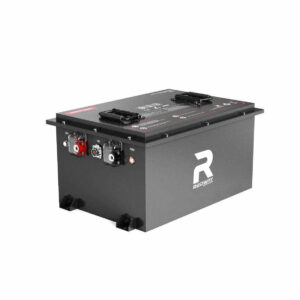Why Is a 48V LiFePO4 Battery Ideal for Your RV?
A 48V LiFePO4 RV battery offers higher energy density, longer lifespan, and faster charging than traditional lead-acid batteries. It supports high-power appliances, reduces weight, and integrates seamlessly with solar systems. With stable voltage output and minimal maintenance, it’s ideal for off-grid adventures. This makes it the top choice for modern RVs prioritizing efficiency and sustainability.
How Does a 48V LiFePO4 Battery Compare to 12V/24V Systems?
48V LiFePO4 systems deliver higher efficiency with lower energy loss over long wire runs compared to 12V/24V setups. They handle heavier loads (e.g., air conditioners, induction cooktops) without voltage drop, reducing the need for bulky wiring. A 48V system also requires fewer batteries in parallel, simplifying installation and cutting weight by up to 60% versus lead-acid alternatives.

What Are the Key Benefits of Upgrading to a 48V RV Battery?
Benefits include 3,000–5,000 cycles (vs. 500–1,000 for lead-acid), 95% usable capacity, and 50% faster charging. A 100Ah 48V LiFePO4 battery stores 5.12kWh, powering a 1,500W AC unit for ~3 hours. It operates efficiently from -20°C to 60°C and weighs 15–25 kg, half the weight of equivalent lead-acid banks. Solar compatibility reduces reliance on generators.
Beyond basic advantages, 48V LiFePO4 batteries excel in extreme conditions. Their low self-discharge rate (3% monthly vs. 30% for AGM) preserves energy during storage. For RVs with solar setups, the higher voltage allows smaller gauge wiring, saving space and cost. The chemistry’s thermal stability minimizes fire risks even in desert climates. Many models now include Bluetooth monitoring, letting users track state-of-charge and diagnose issues via smartphone apps. Fleet operators report 22% lower maintenance costs compared to 24V lead-acid systems due to eliminated watering and equalization cycles.
| Feature | 48V LiFePO4 | 12V Lead-Acid |
|---|---|---|
| Cycle Life | 3,000–5,000 | 500–1,000 |
| Weight (100Ah) | 18 kg | 30 kg |
| Charge Efficiency | 98% | 85% |
Which Safety Features Do 48V Lithium RV Batteries Include?
Built-in Battery Management Systems (BMS) prevent overcharge, over-discharge, and short circuits. LiFePO4 chemistry is non-flammable, with thermal stability up to 270°C (518°F). UL1973-certified models include cell balancing, temperature sensors, and fault alerts. Some feature IP67 waterproofing and shock resistance for off-road durability, ensuring compliance with RVIA/NFPA safety standards.
Can You Integrate a 48V Battery with Solar Panels?
Yes. A 48V LiFePO4 battery pairs efficiently with 150–450V solar arrays via MPPT controllers. It accepts higher input currents (40–100A) than 12V systems, reducing charge time. For example, a 3kW solar setup can recharge a 10kWh 48V bank in ~3.5 hours. Compatibility with hybrid inverters enables seamless grid/solar/generator charging.
What Future Trends Are Shaping 48V RV Battery Technology?
Emerging trends include modular designs for scalable capacity (5–30kWh), AI-driven BMS for predictive maintenance, and solid-state LiFePO4 cells with 400 Wh/kg density. Wireless monitoring via Bluetooth/5G and bidirectional charging (V2L) for powering external devices are gaining traction. Expect 10,000-cycle batteries by 2025, reducing lifetime costs below $0.03 per kWh.
Manufacturers are developing “battery-as-a-service” models where users pay per kilowatt-hour consumed rather than purchasing units outright. Graphene-enhanced electrodes could enable 15-minute full charges by 2026. The rise of vehicle-to-grid (V2G) integration allows RV owners to sell excess solar power back to utilities during peak demand. Recent DOE grants are accelerating research into recyclable components, aiming for 99% material recovery rates. These innovations position 48V systems as central to achieving net-zero RV travel within the next decade.
| Technology | 2024 Status | 2026 Projection |
|---|---|---|
| Energy Density | 150 Wh/kg | 220 Wh/kg |
| Fast Charge | 1.5 hours | 45 minutes |
| Recycle Rate | 75% | 95% |
Expert Views
“48V LiFePO4 systems are revolutionizing RV power,” says a Redway Battery engineer. “We’ve seen a 300% demand surge since 2021. Modern BMS tech allows 90% depth of discharge daily without degradation. Pairing with high-voltage solar arrays cuts recharge times by 40% compared to 12V. This isn’t just an upgrade—it’s the new standard for sustainable RVing.”
Conclusion
48V LiFePO4 batteries offer unmatched efficiency, safety, and longevity for RVs. With advancements in solar integration and smart management, they empower travelers to explore farther while reducing environmental impact. As technology evolves, these systems will become even more accessible, solidifying their role as the cornerstone of modern off-grid power solutions.
FAQs
- How Long Does a 48V RV Battery Last?
- LiFePO4 batteries last 10–15 years or 3,000–5,000 cycles at 80% depth of discharge. This equals 8–12 years of full-time RV use, outperforming lead-acid by 5–8x.
- Can I Charge a 48V Battery with a Generator?
- Yes. Use a 48V-compatible charger or inverter. A 3,000W generator can recharge a 10kWh battery in ~4 hours, 50% faster than 12V systems.
- Are 48V Batteries Compatible with Older RVs?
- Yes, but you’ll need a 48V-to-12V converter for legacy appliances. Rewiring the DC system is recommended for optimal efficiency.
